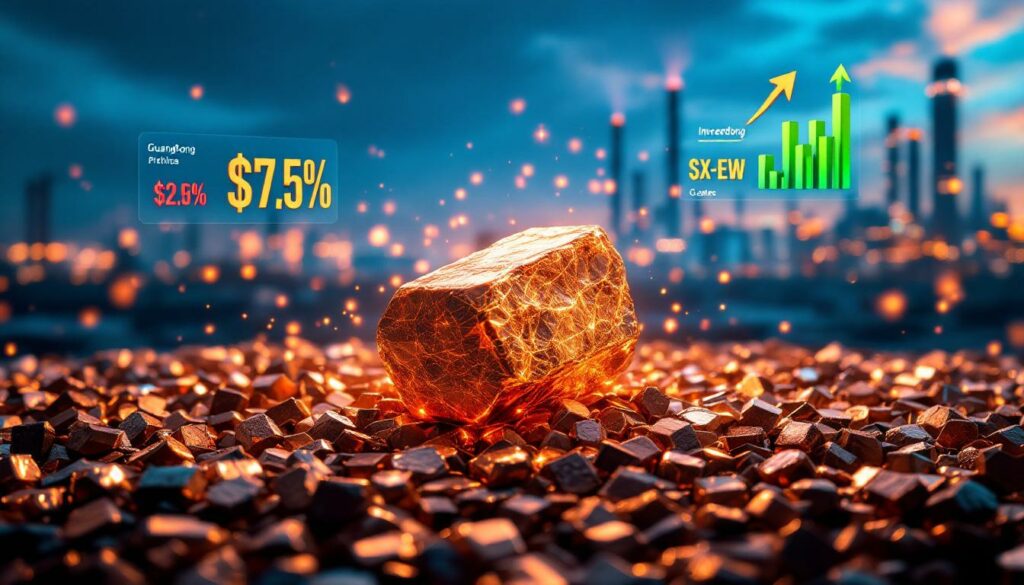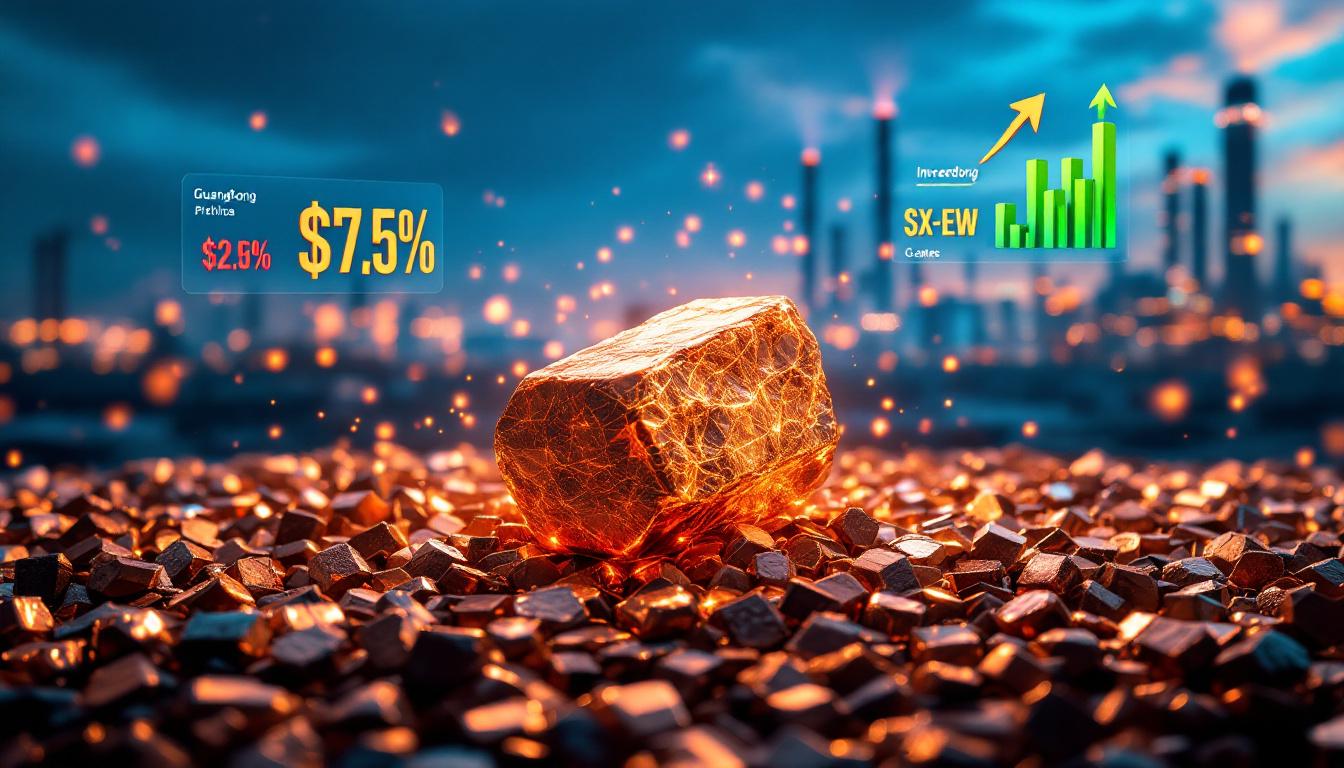What's Happening with Copper Prices and Premiums?
In South China's copper market, a significant trend is emerging as premiums continue to decline despite falling prices. As of July 7, 2025, spot #1 copper cathode is trading within a premium/discount range of -60 to +50 yuan/mt, with an average discount of 5 yuan/mt—representing a 30 yuan/mt decrease from the previous trading day. This unexpected premium reduction contradicts traditional market expectations where lower prices typically stabilize or improve premiums.
SX-EW copper faces even steeper discounts, quoted between -120 and -100 yuan/mt with an average discount of 110 yuan/mt, marking a substantial 50 yuan/mt decrease from the previous day. The absolute price levels have also fallen significantly, with #1 copper cathode averaging 79,805 yuan/mt (down 745 yuan/mt) and SX-EW copper at 79,700 yuan/mt (down 765 yuan/mt).
Regional Premium Structure Breakdown
As of mid-morning trading, a clear quality-based premium hierarchy has emerged in the Guangdong market:
- High-quality copper: Commands a premium of +50 yuan/mt
- Standard-quality copper: Trading at a discount of -80 yuan/mt
- SX-EW copper: Suffering the deepest discount at -130 yuan/mt
This tiered structure reveals how quality differentiation becomes more pronounced during market softness, with buyers willing to pay premiums only for superior material while heavily discounting lower grades.
Market Note: The widening gap between high-quality and SX-EW copper (180 yuan/mt spread) signals intensifying quality sensitivity among buyers who can afford to be selective in a well-supplied market.
Why Are Premiums Falling Despite Price Declines?
The counterintuitive decline in premiums amid falling prices stems from several interconnected factors affecting the South China copper market. Traditionally, lower absolute prices should stimulate buying interest, but current market dynamics are overriding this pattern.
Inventory Pressure Creates Supply Glut
Guangdong's copper inventory has increased for six consecutive days, creating downward pressure on premiums. This consistent inventory build-up indicates that material is arriving faster than it's being consumed, forcing suppliers to offer increasingly attractive terms to move product.
The relationship between rising inventories and falling premiums demonstrates the market's current oversupplied condition. When warehouses fill with copper cathodes and traders hold significant positions, competitive discounting becomes inevitable to generate sales.
Downstream Demand Remains Hesitant
According to SMM market analysts, "Although copper prices have pulled back, downstream consumers remain bearish about future premiums and are reluctant to purchase more." This buyer hesitation creates a self-reinforcing cycle: anticipation of further premium declines leads to purchasing delays, which in turn forces additional premium reductions.
Many fabricators and end-users are practicing strategic procurement by deliberately postponing restocking, calculating that better terms will be available if they wait. This "wait-and-see" approach is particularly evident in non-urgent buying situations where consumers have operational flexibility.
Supplier Concessions Accelerate
Faced with mounting inventory and lackluster demand, suppliers have implemented aggressive pricing strategies. "Suppliers have to continuously lower their prices to stimulate demand, leading to sustained premium declines," notes the latest SMM market report. This competitive price-cutting further reinforces buyer expectations of continuing discounts.
The premium reduction trend appears self-perpetuating in the short term, with each supplier concession validating buyer reluctance and encouraging further procurement delays.
How Does Inventory Affect Copper Premiums?
The relationship between inventory levels and market premiums represents one of the copper market's most reliable correlations. The current situation in Guangdong provides a textbook example of this dynamic.
Inventory Trajectory and Premium Impact
The six consecutive days of inventory increases in Guangdong have created a clear oversupply situation. This accumulation directly translates to weaker premiums as material availability exceeds immediate consumption needs. The correlation is particularly visible in the SX-EW segment, where discounts have deepened to -130 yuan/mt.
When inventories rise, negotiating leverage shifts decisively from sellers to buyers. This power transition manifests in wider discounts as suppliers compete more aggressively for limited spot demand. Conversely, when inventories tighten, premiums typically strengthen as buyers compete for scarce material.
Regional Supply-Demand Balance
The Guangdong region serves as a critical distribution hub for China's copper market, making its inventory situation a bellwether for broader market conditions. Current inventory growth suggests import volumes or domestic production are outpacing regional industrial consumption.
Supply chain participants actively monitor these inventory trends when formulating pricing strategies:
- Traders adjust spot offers based on warehouse movement
- Fabricators time purchases to capitalize on inventory-driven discount cycles
- Producers may adjust production schedules or export volumes in response
As one market participant noted, "Attention should be paid to whether inventory will continue to increase in the future," highlighting how inventory trajectories provide critical forward indicators for premium movements.
What's the Outlook for Copper Market Participants?
The copper market outlook hinges on several interconnected factors, with inventory developments and downstream purchasing behavior taking center stage in determining near-term premium trends.
Short-Term Premium Expectations
Market conditions point toward continued premium weakness in the immediate term, particularly if Guangdong's inventory continues its upward trajectory. The accelerated discount expansion for SX-EW copper (50 yuan/mt daily decline) versus standard cathode (30 yuan/mt) suggests that lower-quality material will face disproportionate pressure in oversupplied conditions.
Price sensitivity varies significantly across copper grades:
| Copper Grade | Current Discount | Discount Change | Price Sensitivity |
|---|---|---|---|
| High-Quality | +50 yuan/mt | Stable | Low |
| Standard | -80 yuan/mt | Moderate decline | Medium |
| SX-EW | -130 yuan/mt | Rapid decline | High |
This differentiated price sensitivity provides strategic opportunities for market participants with grade flexibility in their operations.
Key Indicators to Monitor
Savvy market participants should watch for several potential reversal signals:
- Inventory inflection point: A shift from accumulation to drawdown
- Premium stabilization: Consecutive trading days without further discount expansion
- Downstream restocking: Increased buying interest at current discount levels
- Production cuts: Announcements from smelters reducing output due to unfavorable economics
Any combination of these factors could signal a bottom in the premium market and present advantageous buying opportunities for consumers with available storage capacity. Furthermore, recent copper price prediction models suggest potential recovery in the medium term despite current weakness.
How Do Different Copper Grades Compare in the Current Market?
The copper market features distinct quality tiers with significantly different pricing and premium structures. The current market environment has magnified these differentials, creating notable opportunities and challenges for various market participants.
Quality Premium Differentials
Today's market exhibits a remarkable 180 yuan/mt spread between high-quality copper (+50 yuan/mt premium) and SX-EW copper (-130 yuan/mt discount). This substantial differential underscores the market's quality sensitivity during periods of ample supply.
Historical copper premium patterns show that quality spreads typically widen during market softness as buyers become more selective. The current 180 yuan/mt spread exceeds typical quality differentials, indicating extraordinary market conditions where:
- Premium material maintains value due to specialized application requirements
- Standard material faces moderate discounting to generate sales
- SX-EW copper requires deep discounting to attract interest
These differentials create strategic opportunities for consumers with technical flexibility to substitute lower-grade material in appropriate applications.
Processing Method Impact on Pricing
The production methodology significantly influences copper's market positioning and premium structure. SX-EW (solvent extraction-electrowinning) copper is produced through a hydrometallurgical process rather than the traditional pyrometallurgical smelting and refining route.
SX-EW production offers several advantages, including:
- Lower energy requirements
- Ability to process lower-grade ores
- Reduced environmental footprint for certain deposit types
However, SX-EW material often contains higher levels of specific impurities, particularly organics and certain metals, leading to its consistent discount in premium markets. End-users with stringent purity requirements, such as high-performance wire and cable manufacturers, typically avoid SX-EW material, restricting its market to less demanding applications.
This processing method distinction explains why SX-EW copper faces the deepest discounts (-130 yuan/mt) in the current environment, as quality-sensitive buyers gravitate toward conventionally produced cathodes despite the premium differential.
What Are the Broader Market Implications?
The current copper premium dynamics in South China carry significant implications across the entire supply chain, from mine production to finished products. These market conditions also provide valuable economic signals beyond the metal sector itself.
Supply Chain Adaptation Strategies
Different supply chain participants are implementing distinct strategies to navigate the current premium environment:
Upstream Producers:
- Smelters with high-quality output are maintaining production levels, leveraging their quality premium advantage
- SX-EW producers face margin pressure, potentially leading to production curtailments if discounts widen further
- Some producers are shifting material to different geographic markets seeking better premium structures
Midstream Traders:
- Experienced traders are minimizing inventory positions to avoid exposure to further premium erosion
- Quality arbitrage opportunities have emerged by purchasing discounted material for blending
- Geographic arbitrage between Guangdong and other regions is increasing as traders seek optimal markets
Downstream Fabricators:
- Strategic procurement teams are balancing immediate discount opportunities against inventory carrying costs
- Quality-flexible operations are shifting input specifications to capitalize on deeper SX-EW discounts
- Long-term contract negotiations increasingly focus on premium/discount mechanisms rather than absolute price
These adaptive responses demonstrate how price signals efficiently propagate through the copper supply chain, driving resource allocation and operational decisions. In addition, the global copper supply forecast suggests continued production growth, which could further pressure premiums.
Copper as an Economic Barometer
Copper premiums serve as sensitive indicators of industrial activity, often providing earlier signals than finished goods production statistics. The current premium weakness in Guangdong suggests:
- Potential manufacturing slowdown in Southern China
- Inventory accumulation across the manufacturing supply chain
- Cautious sentiment among industrial procurement teams
This barometric quality explains why copper is often called "Dr. Copper" for its ability to diagnose broader economic conditions. The current premium weakness, coupled with absolute price declines, signals caution regarding near-term industrial activity in the region.
Market Insight: The reluctance of downstream buyers to restock despite lower absolute prices suggests broader economic concerns beyond simple supply-demand dynamics, potentially indicating reduced finished goods orders or export activity.
FAQ About Copper Premiums and Pricing
What causes copper premiums to decline even when prices fall?
Copper premiums reflect local supply-demand dynamics rather than absolute price levels. When downstream buyers anticipate further market weakness or hold sufficient inventory, they delay purchases regardless of price movements. This hesitation forces suppliers to reduce premiums to attract business, creating the counterintuitive situation of declining premiums despite falling prices.
The current market exemplifies this dynamic, with SMM reporting that "downstream consumers remain bearish about future premiums and are reluctant to purchase more" despite the 745 yuan/mt price reduction for #1 copper cathode. Recent copper tariffs impact has also contributed to market uncertainty.
How do inventory levels affect copper premiums?
Inventory levels directly influence premium movements through their impact on perceived material availability. Rising inventories, like the six consecutive days of increases currently observed in Guangdong, signal abundant supply relative to demand, forcing sellers to offer discounts to move material.
This relationship creates predictable premium cycles:
- Low inventory → tight supply perception → strengthening premiums
- Rising inventory → adequately supplied market → stable premiums
- High inventory → oversupplied perception → weakening premiums
- Falling inventory → rebalancing market → premium stabilization
The current Guangdong market sits firmly in stage 3, with premiums declining in response to inventory growth.
What's the difference between SX-EW copper and standard copper cathode?
SX-EW (solvent extraction-electrowinning) copper and standard copper cathode differ in both production methodology and typical quality characteristics:
| Attribute | SX-EW Copper | Standard Cathode |
|---|---|---|
| Production Process | Hydrometallurgical leaching followed by electrowinning | Pyrometallurgical smelting followed by electrolytic refining |
| Typical Purity | 99.97-99.99% | 99.99%+ |
| Common Impurities | Organics, lead, selenium | Minimal trace elements |
| Market Positioning | Typically discounted | Benchmark pricing |
| Current Premium/Discount | -130 yuan/mt | -80 yuan/mt |
| Primary Applications | Construction, less demanding uses | Electronics, high-performance applications |
These differences explain why SX-EW copper trades at deeper discounts (-130 yuan/mt) compared to standard cathode (-80 yuan/mt) in the current market.
How should downstream buyers approach purchasing decisions in this market?
Downstream buyers face a strategic dilemma in the current market: capture today's discounts or wait for potentially deeper discounts in the future. The optimal approach depends on several factors:
- Inventory position: Operations with limited stocks may need to purchase despite expectations of further discounts
- Production requirements: Quality-sensitive applications have less flexibility to switch grades for discount advantage
- Market outlook: Buyers' assessment of how long premium weakness will persist
- Risk tolerance: Willingness to bet on further premium erosion versus securing current terms
A balanced approach includes:
- Maintaining minimum operational inventory through small, regular purchases
- Reserving capacity for opportunistic larger purchases if discounts deepen
- Considering grade substitution where technically feasible
- Exploring longer-term contracts with flexible premium mechanisms
This strategy balances immediate needs against the opportunity to capitalize on favorable market conditions. Despite current challenges, the long-term copper investment surge remains strong, particularly in electrification sectors.
Market Data Comparison Table
| Copper Type | Current Premium/Discount | Previous Day | Change | Average Price (yuan/mt) | Price Change (yuan/mt) |
|---|---|---|---|---|---|
| #1 Cathode | -5 yuan/mt (avg) | +25 yuan/mt | -30 | 79,805 | -745 |
| SX-EW | -110 yuan/mt (avg) | -60 yuan/mt | -50 | 79,700 | -765 |
Market Insight: The accelerated decline in SX-EW copper premiums (-50 yuan/mt) compared to standard cathode (-30 yuan/mt) suggests quality differentiation is becoming more pronounced as market conditions soften.
The premium reduction trend, combined with falling absolute prices, creates a challenging environment for suppliers but potentially favorable conditions for strategic buyers. As inventory levels continue to rise in Guangdong, market participants should closely monitor both inventory trajectories and downstream purchasing behavior for signs of premium stabilization or further deterioration.
While short-term conditions favor buyers, the copper market's cyclical nature suggests this premium weakness will eventually reverse when inventory levels stabilize or decline. Strategic market participants will balance immediate opportunities against longer-term positioning in this dynamic marketplace. For investors looking at diversification strategies, copper-uranium investment opportunities in Australia and Canada present interesting alternatives during this period of decline in copper prices and premiums.
Want to Identify the Next Major Mineral Discovery Before the Market?
Discover why significant mineral finds like De Grey Mining and WA1 Resources delivered exceptional returns by exploring Discovery Alert's dedicated discoveries page. Get real-time notifications of significant ASX mineral discoveries powered by the proprietary Discovery IQ model at https://discoveryalert.com.au/discoveries/.




